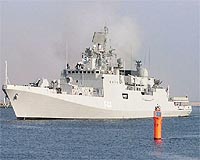| . |  |
. |
Sunnyvale CA (SPX) Oct 30, 2009 Lockheed Martin has announced that the second Space-Based Infrared System (SBIRS) geosynchronous orbit (GEO-2) spacecraft is progressing through a series of key tests that will demonstrate the integrated satellite's readiness to enter the critical environmental test phase in preparation for launch. SBIRS is designed to provide early warning of missile launches, and simultaneously support other missions including missile defense, technical intelligence and battlespace characterization. The test phase, known as Baseline Integrated System Test (BIST), is conducted at Lockheed Martin's Space Systems facilities in Sunnyvale, Calif. and is designed to characterize the overall performance of the GEO-2 satellite and establish a performance baseline prior to entering environmental testing. "Getting our second satellite integrated and into system testing is a major accomplishment for the program," said Lt Col Heath Collins, Commander, SBIRS Space Squadron. "It couldn't have happened without the skill, professionalism, and dedication of the combined SBIRS team. This is yet one more step towards providing revolutionary missile warning capabilities to the warfighters and national decsion makers in the coming years." The first phase of BIST is conducted with the GEO-2 spacecraft in an expanded mode to allow for thorough checkout of the completed spacecraft bus with the infrared payload, which was delivered by the payload subcontractor Northrop Grumman in April 2009 and integrated into the spacecraft core and electronics equipment panels over the summer. Following this test phase, the team will install the equipment panels and communications antennas in the flight configuration for environmental testing, where the integrated spacecraft will be subjected to acoustic and thermal vacuum levels expected during launch and on-orbit operations. GEO-2 is planned for launch in fiscal year 2012. "As the result of the team's continuous process improvement initiatives, we are progressing steadily in our integration and test activities on this second cutting-edge spacecraft," said Keoki Jackson, Lockheed Martin's SBIRS GEO-2 program manager. "We look forward executing this key test and achieving total mission success on this critical national security program." The first SBIRS spacecraft (GEO-1) is currently in thermal vacuum testing, where it has already completed the first of several hot and cold temperature cycles as part of a comprehensive test-like-you-fly process. The extensive test is the last environmental test phase prior to final checkout and shipment to the launch site in late 2010. The SBIRS team is led by the Space Based Infrared Systems Wing at the U.S. Air Force Space and Missile Systems Center, Los Angeles Air Force Base, Calif. Lockheed Martin Space Systems Company, Sunnyvale, Calif., is the SBIRS prime contractor, with Northrop Grumman Electronic Systems, Azusa, Calif., as the payload subcontractor. Air Force Space Command operates the SBIRS system. Share This Article With Planet Earth
Related Links Lockheed Martin Military Space News at SpaceWar.com
 Indian Navy To Get Dedicated Communication Satellite
Indian Navy To Get Dedicated Communication SatelliteNew Delhi, India (PTI) Oct 26, 2009 Navy will get a dedicated satellite for making its communication robust and secure and to also propel its network-centric operations and connectivity at sea, Defence Minister A K Antony said today. "The Navy's efforts towards network centric operations and leveraging information technology are laudable. The launch of the Naval Communication Satellite next year will significantly ... read more |
|
| The content herein, unless otherwise known to be public domain, are Copyright 1995-2009 - SpaceDaily. AFP and UPI Wire Stories are copyright Agence France-Presse and United Press International. ESA Portal Reports are copyright European Space Agency. All NASA sourced material is public domain. Additional copyrights may apply in whole or part to other bona fide parties. Advertising does not imply endorsement,agreement or approval of any opinions, statements or information provided by SpaceDaily on any Web page published or hosted by SpaceDaily. Privacy Statement |